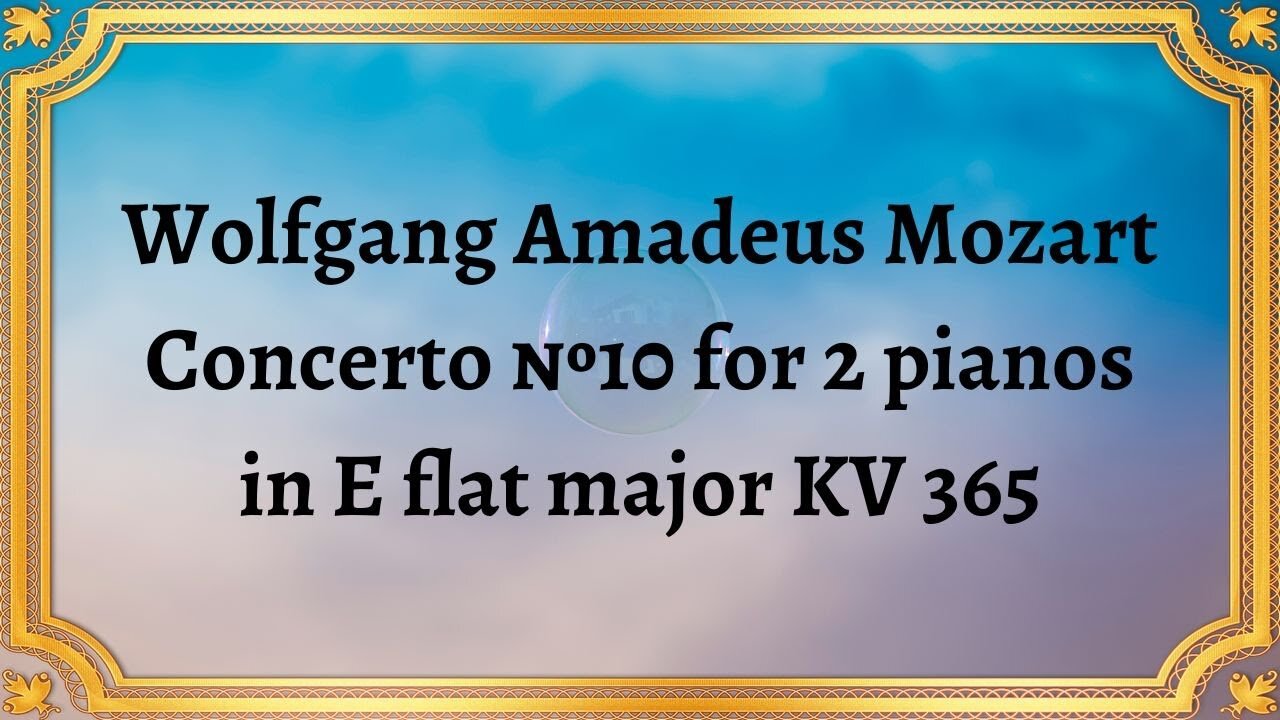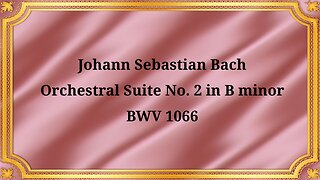Premium Only Content

Wolfgang Amadeus Mozart Concerto №10 for 2 pianos in E flat major KV 365
#Mozart#Chamber_music#Classical_music#Concerto#musical_composition
Publication date 1955
Duo Schnabel: Karl-Ulrich and Helen Schnabel-Fogel, pianos
Ilse von Alpenheim, piano
Wiener Symphoniker c.b. Bernhard Paumgartner
Wolfgang Amadeus Mozart, a prodigious composer of the Classical era, left an indelible mark on the world of music with his masterpieces. Among his exceptional works, Concerto No. 10 for 2 Pianos in E-flat Major, KV 365 shines as a captivating composition.
Mozart composed Concerto No. 10 for 2 Pianos in E-flat Major, KV 365 in Vienna, Austria, in 1779. This period marked the pinnacle of Mozart's creative output, as he experimented with various musical forms and genres. The concerto represents a fascinating chapter in Mozart's oeuvre, showcasing his technical brilliance and compositional innovation.
The concerto comprises three movements, adhering to the traditional fast-slow-fast format commonly found in classical concertos:
Allegro: The opening movement exudes vitality and charm, as the two pianos engage in a spirited dialogue. Mozart's melodic inventiveness shines through intricate passages, showcasing his ability to weave delightful themes and motifs. The movement exhibits a symphonic quality, with the pianos and orchestra engaging in a harmonious conversation.
Andante: The second movement offers a contrasting atmosphere of tranquility and introspection. Here, Mozart delves into a lyrical exploration, allowing the pianos to weave delicate melodies that evoke a sense of emotional depth. The serene interplay between the instruments creates an intimate and introspective ambiance, captivating listeners with its sublime beauty.
Rondo: Allegro: The final movement returns to a lively tempo, exuding a sense of jubilant energy. The pianos dance playfully, exchanging dazzling virtuosic passages and brilliant cascades of notes. The movement culminates in a spirited and triumphant finale, leaving the audience uplifted and spellbound by Mozart's compositional genius.
Mozart's Concerto No. 10 for 2 Pianos in E-flat Major, KV 365 continues to captivate audiences worldwide, thanks to its enduring appeal. Let's explore a few reasons why this composition remains a beloved and celebrated work:
The concerto's dual-piano format allows for a rich interplay between the instruments, creating a unique and captivating dialogue. The pianos complement each other, showcasing Mozart's ability to craft intricate counterpoint and harmonies, resulting in a mesmerizing sonic tapestry.
The composition demands exceptional technical prowess from the pianists, with rapid scale runs, intricate ornamentations, and precise coordination. The virtuosic nature of the concerto adds excitement and showcases the performers' mastery, captivating both musicians and audiences alike.
Mozart's Concerto No. 10 traverses a range of emotions, from exuberance to introspection. Its lyrical melodies, poignant harmonies, and nuanced phrasing evoke a profound emotional response. The work's ability to touch the hearts of listeners has contributed to its enduring popularity throughout the years.
Wolfgang Amadeus Mozart's Concerto No. 10 for 2 Pianos in E-flat Major, KV 365 stands as a testament to the composer's brilliance and artistic vision. Its historical significance, meticulous musical structure, and timeless appeal continue to make it a cherished piece in the classical repertoire. By delving into this remarkable composition, we gain a deeper appreciation for Mozart
-
 20:26
20:26
Classical music_Music Inspiration
1 month agoJohann Sebastian Bach Orchestral Suite No. 2 in B minor, BWV 1066
862 -
 LIVE
LIVE
JuicyJohns
3 hours ago $1.57 earned🟢#1 REBIRTH PLAYER 10.2+ KD🟢$500 GIVEAWAY SATURDAY!
147 watching -
 43:09
43:09
VINCE
2 hours agoSPECIAL: "Obamagate" DEEP-DIVE with Gen. Mike Flynn, Mike Benz and Paul Sperry
87.1K60 -
 LIVE
LIVE
The Big Mig™
3 hours agoFBI Burn Bags, Hidden SCIF’s & Truth About Mar-A-Lago Raid
5,114 watching -
 1:50:11
1:50:11
Dear America
3 hours agoFBI Discovers THOUSANDS Russia Hoax Docs In “Burn Bags”!! + Pelosi EXPOSED For Insider Trading!!
103K77 -
 1:27:12
1:27:12
Tucker Carlson
3 hours agoTony Aguilar Details the War Crimes He’s Witnessing in Gaza
71.6K125 -
 LIVE
LIVE
Badlands Media
6 hours agoBadlands Daily: July 31, 2025
4,128 watching -
 2:16:31
2:16:31
Matt Kohrs
12 hours agoHUGE Earnings Beat, Inflation Data & New Record Highs || Live Trading Options & Futures
28.7K2 -
 19:44
19:44
Bearing
3 hours agoWorld’s CRAZIEST Feminist Wants AMERICANS to WAKE THE F*** UP 🦅💥
18.2K35 -
 47:09
47:09
Randi Hipper
2 hours agoUNITED STATES BITCOIN RESERVE IS COMING! WHITE HOUSE CRYPTO REPORT EXPLAINED
16.4K2